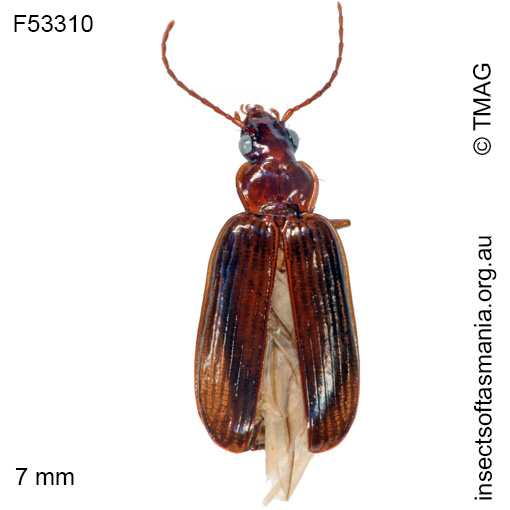
Amblytelus longipennis
Basis for Tasmanian occurrence
TMAG collections
Classification
Suborder: Adephaga
Superfamily: Caraboidea
Family: Carabidae
Subfamily: Moriomorphinae
Morphology
Flightedness: winged and assumed capable of flight
Source literature on morphology and taxonomy (*primary taxonomic source, where identified):
*Baehr, M. (2004). The Amblytelini. Taxonomy, phylogeny, biogeography (Insecta, Coleoptera, Carabidae, Psydrinae). Coleoptera 8: 1-286.
Ecology
Association with dead wood or old trees: at least facultatively saproxylic
Collection method(s) for TMAG material: — Emergence trapping from log of Eucalyptus obliqua — Knockdown fogging of canopy of Eucalyptus obliqua — Malaise trapping — Pitfall trapping — Trapping using a range of devices placed in crown of Eucalyptus obliqua (Bar-Ness, 2005).
Source ecological literature:
Grove, S.J. (2009b). Beetles and fuelwood harvesting: a retrospective study from Tasmania’s southern forests. Tasforests 18: 77-99.
Bar-Ness, Y. (2005). Crown structure and the canopy arthropod biodiversity of 100 year old and old-growth Tasmanian Eucalyptus obliqua. Msc thesis, Univ. of Tasmania, Hobart.
Grove, S.J. (2009c). Do wildlife habitat strips act as refuges for mature-forest carabid beetle assemblages? A case-study in Tasmanian wet eucalypt forest, Australia. For. Ecol. Manage. 259: 496-504.
Yee, M. (2005). The ecology and habitat requirements of saproxylic beetles native to Tasmanian wet eucalypt forests: potential impacts of commercial forestry practices. PhD thesis, Univ. of Tasmania, Hobart.

